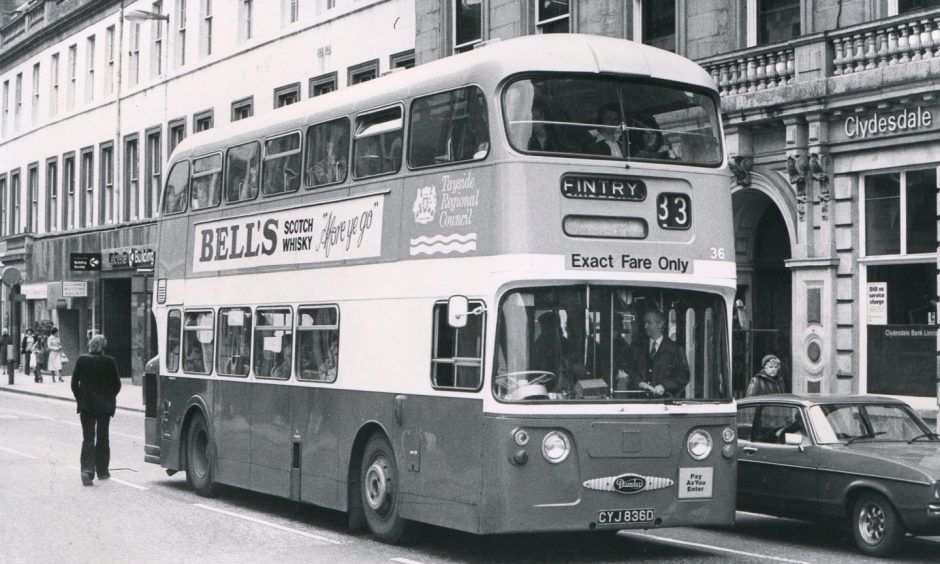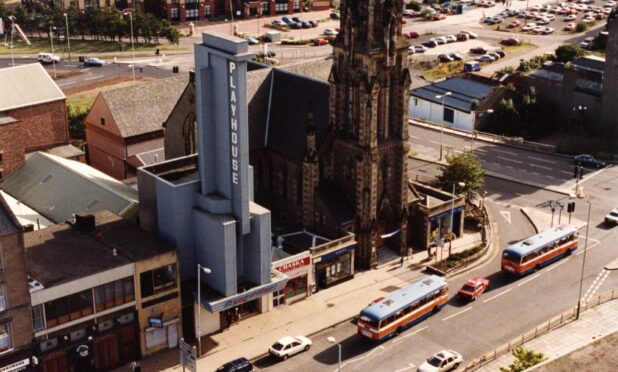
Buses took to the roads in Fintry for the first time 75 years ago.
Inner city overcrowding meant the housing emphasis in Dundee shifted from central areas to peripheral sites in the 1940s.
The first 120 steel-framed dwellings were completed in 1949 on farmland in the north of the city that became known as the Fintry housing estate.
Few people had cars and one Evening Telegraph letter writer, in May 1949, highlighted the growing demand for a dedicated bus service.
She said: “Isn’t it high time Dundee Corporation had a bus service to Mains of Fintry housing scheme?
“The number of people who have to walk several times a day to and from Maryfield tram terminus is increasing with more and more houses being occupied.
“School children have so little time at the lunch hour that they run all the way.
“Surely it’s not too much to ask for a shuttle service with one bus at peak periods?”
A Fintry bus route started in 1949
A bus route provided Fintry with direct access to the city centre and ran from Shore Terrace bus station via Dura Street and Forfar Road.
The service was numbered 19.
The fare for the full journey was two-and-a-half pence.
The service from town started at 6.20am, Monday to Friday.
It would see a bus running every 10 minutes during rush hour and every 15 minutes in quieter periods.
The last bus was 11.30pm.
The service from Fintry to the city centre started at 6.35am and finished at 11.45pm.
There was a service every 15 minutes on Sunday.
The bus service was well used.
A section of Fintry Road had still to the built when bus services were established.
Derek Simpson has written extensively about Dundee buses and has collected 10,000 photographs of the city’s fleet during his lifetime.
“The evolution of the service to the Fintry housing scheme was largely dictated by its population growth,” said Derek.
“For a time buses actually displayed Fintryside in their destination screen.
“When the scheme was being built Fintry Road was only made up as far as Fintryside, so the assumption has been made that the service terminated at this point.”
A housing boom was in full swing
There were 2,000 cottages and 800 tenement flats built in the Fintry estate following the sheer growth in demand for housing between 1949 and 1960.
“By 1953 Fintry was growing rapidly northwards and Dundee Corporation Transport needed to get buses nearer to where the residents lived,” said Derek.
“This resulted in the Fintry route being revised with buses leaving the Forfar Road at Fintry Road where they continued to Finavon Terrace and turned left.
“They then proceeded north and travelled as far as Fintry Drive.
“At this point they turned right, heading east towards the junction with Fintry Road, where they then turned right, terminating at the junction with Finlarig Terrace where the buses reversed, ready for the return journey.
“Whilst this route might seem odd today, it has to be borne in mind that until 1959 a section of Fintry Road, particularly around Fintry Mains, had still to be built, hence the odd routing arrangement at that time.”
In readiness for his departure to the city centre, the conductor would insert his time card into the Bundy clock at the junction of Fintry Road and Finlarig Terrace.
The Bundy clock was a driver tracking device.
It was impossible to police large sections of a bus network with inspectors and the stamp would show the bosses what time the bus left the stop.
Derek said there were numerous tales of how to make the time stamp less legible if there were issues with the departure time that could not be explained.
The transport future lay with the buses
By the early 1950s the city’s boundaries and housing was extending way beyond the original tram routes,
One survey showed that 95% of daily passengers in Dundee preferred buses to trams.
The last tram ran from Maryfield to Lochee in October 1956.
The fleet was piled up afterwards and burned in a field at Marchbanks.
Maryfield became a bus depot after the final trams were taken to the breaker’s yard.
Two batches of former London Transport buses were garaged there.
Derek said they were easily distinguishable by the roof route number box, the rope bell in the lower saloon and the winding windows for ventilation.
They served Fintry in the 1950s and 1960s.
Derek said: “When the trams were withdrawn in 1956, the decision was taken to join the Fintry services with those in the west end of Dundee that had previously relied on the tram service.
“The outgoing tram service had run from the Sinderins or Ninewells to Maryfield, so arguably the extension to Fintry was not a great surprise.
“Dundee Corporation Transport took the opportunity in 1959 to make more changes as the scheme continued to expand and passenger demand grew.
“Service 19 was replaced with new services 31, 32 and 33.”
All three went straight up Fintry Road and split up at the junction with Fintry Drive.
Service 31 turned left along Fintry Drive and terminated at Finavon Terrace.
The 32 went straight up to Findowrie Street.
The 33 turned right to terminate at Finmore Place.
Comic turn made national headlines
Derek said there would also be a duplicate numbered 34 that would terminate at the old Finlarig Terrace terminus when required during peak time.
The 36 and 37 also passed through Fintry in the 1960s and 1970s.
The colour of the buses would change from green to blue with a white relief band after Dundee Corporation was consigned to history in 1975.
The Fintry to Ninewells service made national headlines when wig-wearing bus conductor Peter MacIntyre appeared in The Sunday Post.
Mrs Edith Anderson was prompted to write to the paper praising him after he cheered up the passengers on the route early one morning in June 1978.
The Sunday Post read: “As he collected fares, he’d a friendly quip for everyone, with a background of pop music from his transistor.
“He asked one woman if he could give her the kiss of life.
“She was out of puff after running for the bus.
“Mrs Anderson was reading the paper when he plonked down beside her wearing a lop-sided false moustache!
“Next, he appeared with the moustache upside down.
“Then it was over one eye.
“As the bus zoomed past after Mrs Anderson got off, he was swinging from the pole Tarzan-style, shouting: ‘Ta-ra, darling’ with a lady’s curly wig on his head!
“She was left in hysterics on the pavement.”
Still racking up the miles since 1949
The Volvo Ailsa blue and white double-decker buses served the 32 and 33 routes in the 1980s.
The trend swung to single-deckers in the early 1990s.
Low-floor buses were introduced on the Fintry services in 1997.
This is when National Express purchased Tayside Buses and ushered in the Travel Dundee era.
The wheels of time keep turning and many things have changed beyond recognition in Fintry.
But buses have remained a constant since September 1949, racking up the miles and the memories.





















Conversation